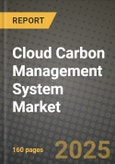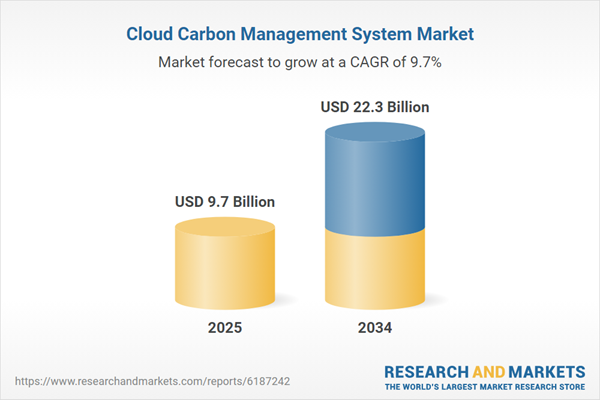The cloud carbon management system market is emerging as a critical component in the global push toward environmental sustainability. These systems leverage cloud-based technologies to track, measure, and report carbon emissions and other environmental metrics across organizations. By providing a centralized, accessible platform, cloud carbon management solutions help businesses understand their environmental impact, identify areas for improvement, and meet increasingly stringent regulatory requirements. This capability is especially important as companies face growing pressure from stakeholders, customers, and governments to adopt greener practices and achieve net-zero emissions targets.
Key trends in the market include the integration of advanced analytics and artificial intelligence (AI) to enhance carbon footprint calculations and provide actionable insights. Companies are increasingly turning to cloud platforms that enable real-time monitoring of emissions, as well as scenario modeling to evaluate the impact of various sustainability initiatives. Additionally, the adoption of standardized reporting frameworks and certifications is becoming more common, helping businesses ensure compliance and improve transparency. As industries prioritize sustainability, the cloud carbon management system market is poised to play a pivotal role in helping organizations transition to more environmentally responsible operations.
Despite its growing importance, the market faces challenges such as data integration complexities, the need for accurate and reliable emissions data, and the initial costs associated with implementing these systems. Companies must also navigate diverse regulatory environments and varying global standards. However, as governments and industry bodies introduce more incentives and mandates for carbon transparency, and as cloud technology continues to advance, the cloud carbon management system market is expected to expand significantly, enabling businesses to achieve their sustainability goals more efficiently and effectively.
Key Insights: Cloud Carbon Management System Market
- Integration of AI and advanced analytics for more accurate carbon footprint calculations.
- Real-time monitoring and scenario modeling capabilities for proactive sustainability planning.
- Increased adoption of standardized reporting frameworks and certifications for transparency and compliance.
- Expansion of partnerships between technology providers and environmental organizations to enhance platform capabilities.
- Focus on user-friendly interfaces and intuitive dashboards to simplify carbon management for all stakeholders.
- Growing regulatory pressures and mandates for carbon transparency and reporting.
- Increasing corporate commitments to achieving net-zero emissions targets and sustainability goals.
- Advancements in cloud computing technology enabling scalable, real-time carbon management solutions.
- Rising consumer and investor demand for environmentally responsible business practices.
- Complexity in integrating diverse data sources and ensuring accurate emissions data.
- High initial implementation costs and the need for ongoing maintenance and updates.
- Navigating varying global regulatory environments and standards.
Cloud Carbon Management System Market Segmentation
By Component
- Solutions
- Services
By Applications
- Large Enterprises
- Small and Medium Enterprises (SMEs)
By Industry
- Energy and Utilities
- Manufacturing
- Residential and Commercial Building
- Transportation and Logistics
- IT and Telecom
- Other Industries
Key Companies Analysed
- Engie SA
- The International Business Machines Corporation (IBM)
- Schneider Electric SE
- SAP SE
- Salesforce Inc.
- Enablon (Wolters Kluwer N.V.)
- IHS Markit
- Trinity Consultants Inc.
- Enviance Inc.
- Thinkstep
- Intelex Technologies ULC
- Climeworks AG
- IsoMetrix Software
- Hara Software
- Carbon Clean Solutions
- Carbon Lighthouse
- Locus Technologies
- Energetics
- EnergyCAP LLC
- CarbonCure Technologies
- FirstCarbon Solutions
- Envirosoft Corporation
- Carbon Footprint Ltd.
- Climate Earth
- Greenstone+
- Native Energy
- Dakota Software
- ESP (New Zealand Green Investment Finance)
- COzero
- Ecometrica
Cloud Carbon Management System Market Analytics
The report employs rigorous tools, including Porter’s Five Forces, value chain mapping, and scenario-based modeling, to assess supply-demand dynamics. Cross-sector influences from parent, derived, and substitute markets are evaluated to identify risks and opportunities. Trade and pricing analytics provide an up-to-date view of international flows, including leading exporters, importers, and regional price trends.
Macroeconomic indicators, policy frameworks such as carbon pricing and energy security strategies, and evolving consumer behavior are considered in forecasting scenarios. Recent deal flows, partnerships, and technology innovations are incorporated to assess their impact on future market performance.Cloud Carbon Management System Market Competitive Intelligence
The competitive landscape is mapped through proprietary frameworks, profiling leading companies with details on business models, product portfolios, financial performance, and strategic initiatives. Key developments such as mergers & acquisitions, technology collaborations, investment inflows, and regional expansions are analyzed for their competitive impact. The report also identifies emerging players and innovative startups contributing to market disruption.
Regional insights highlight the most promising investment destinations, regulatory landscapes, and evolving partnerships across energy and industrial corridors.Countries Covered
- North America - Cloud Carbon Management System market data and outlook to 2034
- United States
- Canada
- Mexico
- Europe - Cloud Carbon Management System market data and outlook to 2034
- Germany
- United Kingdom
- France
- Italy
- Spain
- BeNeLux
- Russia
- Sweden
- Asia-Pacific - Cloud Carbon Management System market data and outlook to 2034
- China
- Japan
- India
- South Korea
- Australia
- Indonesia
- Malaysia
- Vietnam
- Middle East and Africa - Cloud Carbon Management System market data and outlook to 2034
- Saudi Arabia
- South Africa
- Iran
- UAE
- Egypt
- South and Central America - Cloud Carbon Management System market data and outlook to 2034
- Brazil
- Argentina
- Chile
- Peru
Research Methodology
This study combines primary inputs from industry experts across the Cloud Carbon Management System value chain with secondary data from associations, government publications, trade databases, and company disclosures. Proprietary modeling techniques, including data triangulation, statistical correlation, and scenario planning, are applied to deliver reliable market sizing and forecasting.Key Questions Addressed
- What is the current and forecast market size of the Cloud Carbon Management System industry at global, regional, and country levels?
- Which types, applications, and technologies present the highest growth potential?
- How are supply chains adapting to geopolitical and economic shocks?
- What role do policy frameworks, trade flows, and sustainability targets play in shaping demand?
- Who are the leading players, and how are their strategies evolving in the face of global uncertainty?
- Which regional “hotspots” and customer segments will outpace the market, and what go-to-market and partnership models best support entry and expansion?
- Where are the most investable opportunities - across technology roadmaps, sustainability-linked innovation, and M&A - and what is the best segment to invest over the next 3-5 years?
Your Key Takeaways from the Cloud Carbon Management System Market Report
- Global Cloud Carbon Management System market size and growth projections (CAGR), 2024-2034
- Impact of Russia-Ukraine, Israel-Palestine, and Hamas conflicts on Cloud Carbon Management System trade, costs, and supply chains
- Cloud Carbon Management System market size, share, and outlook across 5 regions and 27 countries, 2023-2034
- Cloud Carbon Management System market size, CAGR, and market share of key products, applications, and end-user verticals, 2023-2034
- Short- and long-term Cloud Carbon Management System market trends, drivers, restraints, and opportunities
- Porter’s Five Forces analysis, technological developments, and Cloud Carbon Management System supply chain analysis
- Cloud Carbon Management System trade analysis, Cloud Carbon Management System market price analysis, and Cloud Carbon Management System supply/demand dynamics
- Profiles of 5 leading companies - overview, key strategies, financials, and products
- Latest Cloud Carbon Management System market news and developments
Additional Support
With the purchase of this report, you will receive:- An updated PDF report and an MS Excel data workbook containing all market tables and figures for easy analysis.
- 7-day post-sale analyst support for clarifications and in-scope supplementary data, ensuring the deliverable aligns precisely with your requirements.
- Complimentary report update to incorporate the latest available data and the impact of recent market developments.
This product will be delivered within 1-3 business days.
Table of Contents
Companies Mentioned
- Engie SA
- The International Business Machines Corporation (IBM)
- Schneider Electric SE
- SAP SE
- Salesforce Inc.
- Enablon (Wolters Kluwer N.V.)
- IHS Markit
- Trinity Consultants Inc.
- Enviance Inc.
- Thinkstep
- Intelex Technologies ULC
- Climeworks AG
- IsoMetrix Software
- Hara Software
- Carbon Clean Solutions
- Carbon Lighthouse
- Locus Technologies
- Energetics
- EnergyCAP LLC
- CarbonCure Technologies
- FirstCarbon Solutions
- Envirosoft Corporation
- Carbon Footprint Ltd.
- Climate Earth
- Greenstone+
- Native Energy
- Dakota Software
- ESP (New Zealand Green Investment Finance)
- COzero
- Ecometrica
Table Information
| Report Attribute | Details |
|---|---|
| No. of Pages | 160 |
| Published | October 2025 |
| Forecast Period | 2025 - 2034 |
| Estimated Market Value ( USD | $ 9.7 Billion |
| Forecasted Market Value ( USD | $ 22.3 Billion |
| Compound Annual Growth Rate | 9.7% |
| Regions Covered | Global |
| No. of Companies Mentioned | 30 |









